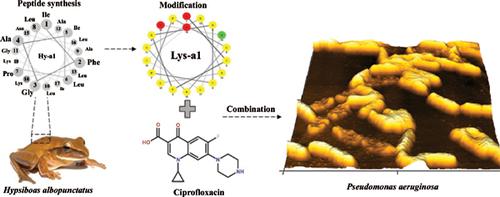Protein & Peptide Letters ( IF 1.0 ) Pub Date : 2020-10-31 , DOI: 10.2174/0929866527666200416145549 Victor Alves Carneiro 1, 2 , Simone Torres de Oliveira 1 , Rondinely Lima Silva 1 , Humberlania de Sousa Duarte 1 , Maria Laína Silva 1 , Maria Nágila Carneiro Matos 1 , Rafaela Mesquita Bastos Cavalcante 1 , Ciro Siqueira Figueira 1 , Esteban Nicolás Lorenzón 3 , Eduardo Maffud Cilli 4 , Rodrigo Maranguape Silva da Cunha 1

|
Background: Ciprofloxacin (Cip) is the most commonly used quinolone in clinical practice; however large-scale use has favored the increase of multiresistant pathogenic microorganisms. Antimicrobial peptides (AMPs) appear to be a promising alternative in potentiating these conventional drugs.
Objective: The aim of this study was to evaluate the effect of the peptide Lys-[Trp6]hy-a1 (lys-a1) on the antimicrobial and antibiofilm activity of ciprofloxacin against clinically relevant gram-negative bacteria.
Methods: The antimicrobial effects of Cip and lys-a1 were assessed by determining the minimum inhibitory concentrations (MICs) and minimum bactericidal concentrations (MBCs). The synergistic action of Cip and lys-a1 was determined by checkerboard assay. The time-kill curve was constructed for the Cip/lys-a1 combination against Pseudomonas aeruginosa ATCC 9027. The antibiofilm activity of this combination was analyzed by crystal violet, colony-forming unit count and atomic force microscopy (AFM).
Results: The data demonstrated that lys-a1 was able to inhibit planktonic growth of strains of P. aeruginosa and Klebsiella pneumoniae both at 125 μg/mL. The fractional inhibitory concentration index (FICi) showed a synergistic effect between Cip and lys-a1 against P. aeruginosa, decreasing the MICs of the individual antimicrobial agents by 4- and 8-fold, respectively. This effect was also observed for the death kinetics and antibiofilm activity. Analysis of the early biofilms (6 h) as well as isolated cells by AFM images evidenced the cell perturbation caused by Cip/lys-a1 treatment.
Conclusion: These data suggest that lys-a1 has biotechnological potential as a therapeutic tool for the treatment of infections caused by clinically relevant microorganisms, especially P. aeruginosa.
中文翻译:

Lys- [Trp6] hy-a1联合环丙沙星对革兰氏阴性菌的抗菌和生物膜活性。
背景:环丙沙星(Cip)是临床上最常用的喹诺酮。然而,大规模使用已经有利于增加多抗性病原微生物。抗菌肽(AMP)似乎是增强这些常规药物的有前途的替代方法。
目的:本研究的目的是评估Lys- [Trp6] hy-a1(lys-a1)肽对环丙沙星对临床相关革兰氏阴性细菌的抗菌和抗生物膜活性的影响。
方法:通过确定最小抑菌浓度(MICs)和最小杀菌浓度(MBCs)评估Cip和lys-a1的抗菌作用。通过棋盘试验确定Cip和lys-a1的协同作用。构建了针对铜绿假单胞菌ATCC 9027的Cip / lys-a1组合的杀灭时间曲线。通过结晶紫,菌落形成单位计数和原子力显微镜(AFM)分析了该组合的抗生物膜活性。
结果:数据表明,lys-a1能够以125μg/ mL的浓度抑制铜绿假单胞菌和肺炎克雷伯菌的浮游生长。抑制分数浓度指数(FICi)显示Cip和lys-a1对铜绿假单胞菌具有协同作用,使单个抗菌剂的MIC分别降低了4倍和8倍。还观察到了死亡动力学和抗生物膜活性的这种作用。通过AFM图像分析早期生物膜(6小时)以及分离的细胞,证明了由Cip / lys-a1处理引起的细胞扰动。
结论:这些数据表明,lys-a1具有潜在的生物技术潜力,可用于治疗由临床相关微生物(尤其是铜绿假单胞菌)引起的感染。











































 京公网安备 11010802027423号
京公网安备 11010802027423号